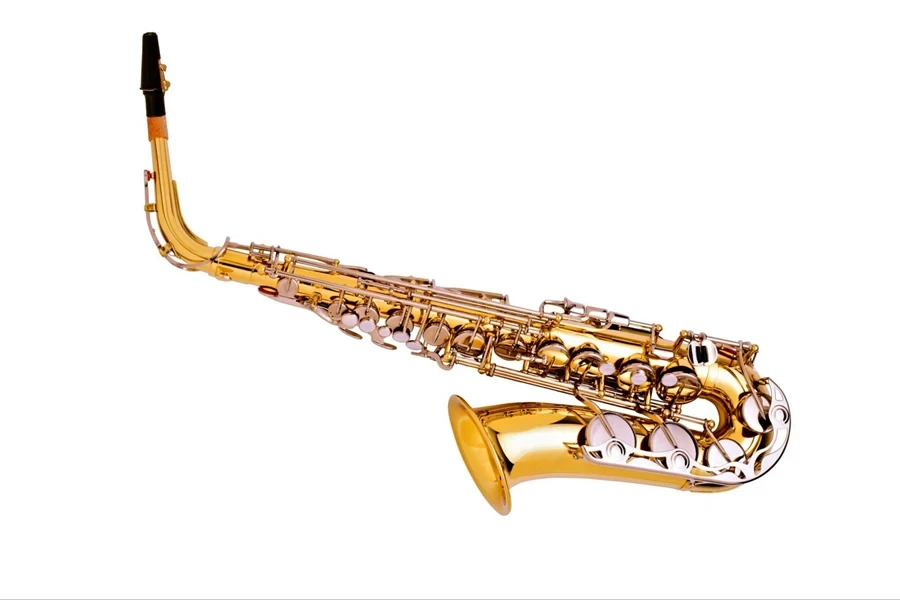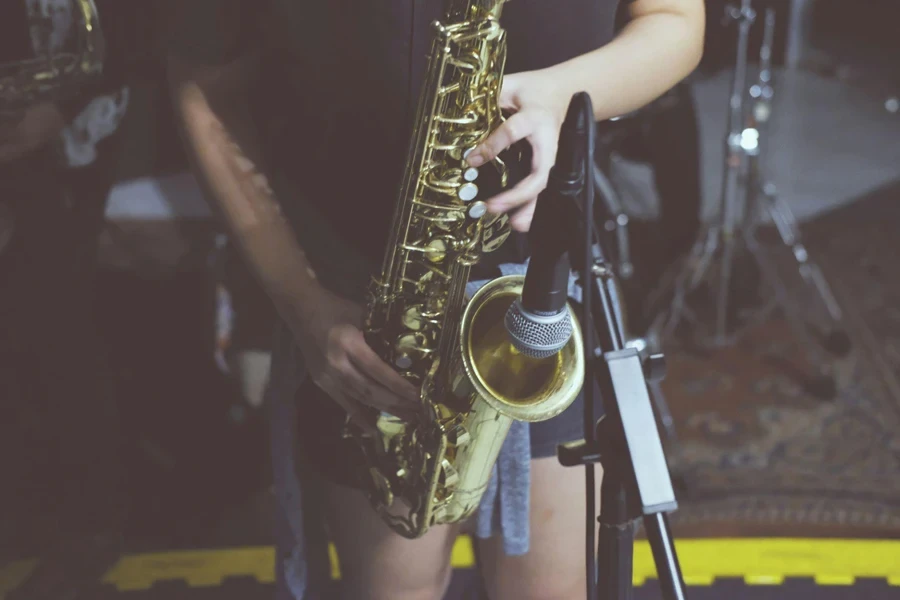Table of Contents
● Introduction
● Saxophones Market Dynamics
● Key Considerations of Selection
● Top Saxophone Picks for 2024
● Conclusion
Introduction
The saxophone, with its rich tones and versatile expression, continues to captivate musicians and audiences alike. As we step into 2024, the quest for the perfect saxophone becomes more nuanced, reflecting advancements in design, materials, and player preferences. This guide aims to help business professionals and online retailers to navigate through these choices, ensuring both aspiring and seasoned saxophonists find their ideal match.
Saxophones Market Dynamics
The global acoustic saxophone market is experiencing a vibrant phase of growth and innovation. With a projected Compound Annual Growth Rate (CAGR) of approximately 2.5% from 2023 to 2028, the industry is thriving, driven by increasing interest in music education, jazz ensembles, and solo performances. The market size, which was valued at around USD 1.2 billion in 2023, is expected to reach new heights, thanks to technological advancements and a growing demand for both student and professional models.
The saxophones market is characterized by a variety of segments, including soprano, alto, tenor, and baritone saxophones, among others. The acoustic saxophone market is expected to grow at a Compound Annual Growth Rate (CAGR) of 4.88% from 2024 onwards. Another segment, the alto saxophone market, is projected to grow at a CAGR of 5.1% from 2024 to 2030. The digital transformation in manufacturing processes and the rise of e-commerce platforms have also played pivotal roles in expanding market reach and accessibility. The market is influenced by major players such as Conn Selmer, Yamaha, Yanagisawa, KHS, Buffet Crampon, Cannonball, and Sahduoo Saxophone, which contribute significantly to the industry’s competitive landscape.

Key Considerations of Selection
Skill Level and Saxophone Type
Selecting the appropriate saxophone based on a player’s experience level.
Beginners:
- Alto Saxophone: The alto saxophone is known for its versatility, expressive tone, and approachable nature, making it a popular choice for beginners. Its manageable size and ergonomic key placement make it relatively easier to control intonation and play fast melodic lines, which is ideal for new learners.
Intermediate Players:
- Tenor Saxophone: The tenor saxophone offers a rich, expressive sound and captures the soulful essence of jazz, making it suitable for intermediate players looking to explore a deeper tone and a broader range of musical expression. Its larger size compared to the alto saxophone requires some adjustment, but it provides a good balance between control and flexibility.
Professionals:
- Soprano Saxophone: The soprano saxophone, with its distinctive sound and challenging nature, requires precise mouthpiece control and a good ear for pitch, making it appealing for professional players seeking unique challenges. Its bright timbre and soaring melodies add a unique voice to any musical ensemble.

- Baritone Saxophone: The baritone saxophone stands out with its deep resonance and commanding presence. It requires physical strength and strong breath support due to its size and weight, offering a unique challenge for professionals. Its powerful projection and ability to hold down the low end make it a key instrument in many ensembles.
Material and Construction
Brass: Brass is the primary material used in making saxophones, favored for its resistance to rusting and tarnishing, lustrous appearance, lightweight nature, affordability, and malleability. This makes brass saxophones ideal for producing the classic, bright saxophone sound.
Bronze: Occasionally, saxophones are made from bronze, which deepens the tone and makes it mellower. This material is suitable for jazz and classical music due to its warmer, darker tone.
Silver Brass: A variant known as silver brass includes nickel in its composition, offering a darker and fuller tone with a characteristic whitish color. Although rare, saxophones made of silver brass are noted for their enhanced brightness and projection, making them preferred by professionals for their crisp sound.
Other Materials: Saxophones can also be made from Sterling Silver, pure silver, or pure gold, and parts of saxophones can be specialized with different materials to target specific areas for euphonious sounds. The choice of material significantly affects the timbre, resonance, and resistance of the saxophone, with denser materials producing deeper and fuller tones.

Key Features and Ergonomics
Key Layout: The saxophone is an ingeniously designed instrument that accounts for the natural positioning of the fingers. With around 600 parts, including 25 tone holes, the instrument uses keys and levers to allow the player to close these holes simultaneously, facilitating comfortable and natural finger placement. The adjustable thumb rests and key heights further customize the fit for each player, enhancing ergonomics and ease of play.
Mouthpiece: The mouthpiece, along with the ligature and reed, plays a crucial role in sound production and playability. Beginners are advised to start with a standard mouthpiece, which is designed to produce a clear, consistent sound. Professionals, however, often seek custom options that allow for greater control and expression in their performance. The material and shape of the mouthpiece can significantly affect the instrument’s tonal quality and responsiveness.
Neck Design: The saxophone’s neck is a critical component influencing the instrument’s tone and responsiveness. Its curvature and design are meticulously crafted to ensure optimal sound production and ease of play. The neck’s construction, combined with the saxophone’s conical bore, contributes to its distinctive sound, blending the warmth of woodwinds with the power of brass instruments. The design of the neck, including the octave key mechanism, is engineered to facilitate smooth transitions between registers and improve the overall playability of the instrument.
Sound Quality and Intonation
Tone: The saxophone is renowned for its dynamic range, the widest among woodwinds, and its ability to produce tones very close to the human voice. This range enables it to deliver a rich, full-bodied sound across all registers, as desired. Its unique design allows it to bridge the gap between the brass and woodwind families, blending the divergent tones to create a rich voice and charm. This capability is crucial for achieving the desired tone, providing the saxophone with the versatility to perform in various musical genres, from the robust repertoire of classical music to the expressive solos in jazz.
Intonation: The saxophone’s capability to maintain accurate pitch throughout its range is a testament to quality craftsmanship. This precision is partly attributed to its conical-bored design, which affects the instrument’s intonation and sound projection. The design and material of the reed, mouthpiece, and neck, in conjunction with the player’s control and technique, also play significant roles in ensuring the saxophone’s intonation remains consistent across its extensive dynamic range. The instrument’s ability to blend well with both brass and woodwinds, reinforcing the lower range of the woodwinds while balancing the tonal quality, further highlights its exceptional intonation capabilities.

Top Saxophone Picks for 2024
For Beginners: Yamaha YAS-280
- The Yamaha YAS-280 saxophone is designed with high durability, easy playability, and consistent intonation, making it an ideal starter instrument. It balances quality with affordability, providing beginners with a reliable saxophone that encourages development and growth. Yamaha’s reputation for quality craftsmanship ensures that even entry-level instruments like the YAS-280 benefit from attention to detail and design excellence, making it a favored choice for new players seeking a solid foundation in their musical journey.
For Professionals: Yanagisawa WO Series
- The Yanagisawa WO Series stands out for professional saxophonists due to its exceptional craftsmanship, innovative design, and unparalleled tone. Tailored to meet the demanding needs of professional players, this series offers precision and versatility. With a focus on ergonomic key placement and refined sound projection, Yanagisawa saxophones are celebrated for their ability to deliver performance and reliability, making them a top selection for professionals seeking instruments that can elevate their musical expression.
For Jazz Enthusiasts: Keilwerth SX90R Shadow
- The Keilwerth SX90R Shadow saxophone, with its unique black nickel finish, powerful sound projection, and ergonomic key placement, is particularly favored among jazz saxophonists. Its distinctive tone and appearance set it apart, catering to musicians who value both style and substance. The SX90R Shadow’s design and build quality reflect Keilwerth’s commitment to providing saxophonists with instruments that inspire creativity and stand out in performance settings.

For Classical Musicians: Selmer Paris Series III
- The Selmer Paris Series III is a top choice for classical performers, known for its warm, rich tone, precise intonation, and responsive key action. This series embodies Selmer’s dedication to superior dynamics and expressive capabilities, making it highly sought after by classical musicians. The craftsmanship of the Selmer Paris Series III allows for a level of expression that meets the exacting demands of classical music, providing performers with an instrument that truly resonates with their artistic ambitions.
Conclusion
Selecting the right saxophone is a journey that intertwines personal preference with technical considerations. The market in 2024 offers a plethora of options tailored to every level and style of play. By focusing on key considerations such as skill level, material, ergonomics, and sound quality, musicians can find an instrument that not only meets their current needs but also supports their growth and evolution as artists. Remember, the best saxophone is one that feels like an extension of the player, enabling your customer to express his or her musicality to its fullest.




